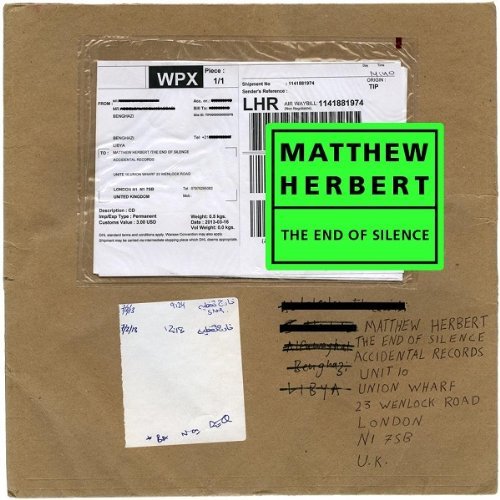Matthew Herbert
The End of Silence
[Edit this Release]
- Artists:
- Matthew Herbert »
- Label:
- Accidental »
Release Date:
24/06/2013
- Artists:
- Matthew Herbert »
- Label:
- Accidental »
Buy now from:

Following on from Matthew Herbert's 'One' trilogy - One One, One Club and One Pig - 'The End of Silence' takes the idea of a single sound source to its logical conclusion by utilizing only one ten second audio recording as the sole source for the whole album. Matthew was emailed a recording made by photographer Sebastian Meyer sebmeyer.com / war-sounds during the battle of Ras Lanuf in Libya on 11th March 2011. In the brief recording, a pro-Gadaffi plane can be heard approaching, a whistled warning, a shout and then, as if from nowhere, a bomb. It is this recording that makes up the entirety of this record. Herbert says, 'I wanted to freeze history, press pause, wander around inside the sound - trying to understand its component parts, wondering why it was so scary when I had never actually heard any bomb first hand. In stark contrast to the written reports of the atrocities committed by dictators in the Arab word during the Arab Spring, here was something that rendered it real. It turned the virtual word back in to the visceral. Despite immediate and disparate access to news of world events, it's rare to find something that punctures the safe veneer of distance that computers create. By hearing this sound, one is compelled to live inside the moment.' This brief, terrifying audio recording was fragmented and atomised into a range of sample instruments and played by Matthew's band. That solitary whistle becomes a tone to be used for harmony; the shrapnel becomes percussion parts etc. For the first time, all the music on this record is played rather than programmed, mostly on bespoke musical instruments. As such, it is Herbert's first truly electronic band. Freed from the constraints of programming, click tracks and other confines of music software, it is a chance for Yann Seznec, Tom Skinner, Sam Beste and Matthew to improvise around the material. 'In many ways i think of it as a jazz quartet record' says Herbert 'we are just now improvising and playing with texture, memory, meaning, and friction as well as the usual tenets of melody, harmony and rhythm . The final album, in three parts, is pieced together from five of these free takes shortened and glued together. The album was recorded over three days in a hillside barn near Hay-on-Wye in June 2012. Matthew employed what he describes as 'witness mics'. These are open mics that were set up outside the barn, recording the world in real time in parallel with each take. In this way, they can help testify to the integrity of the recording process, and at the same time record the contrasting sounds of the session environment, far removed from the horrors of Libya. Occasionally you can hear birdsong or a dog bark. It is a form of veriphonics - a desire to record something truer than what usually is captured inside the confines of a traditional recording studio.
description from www.roughtrade.com

